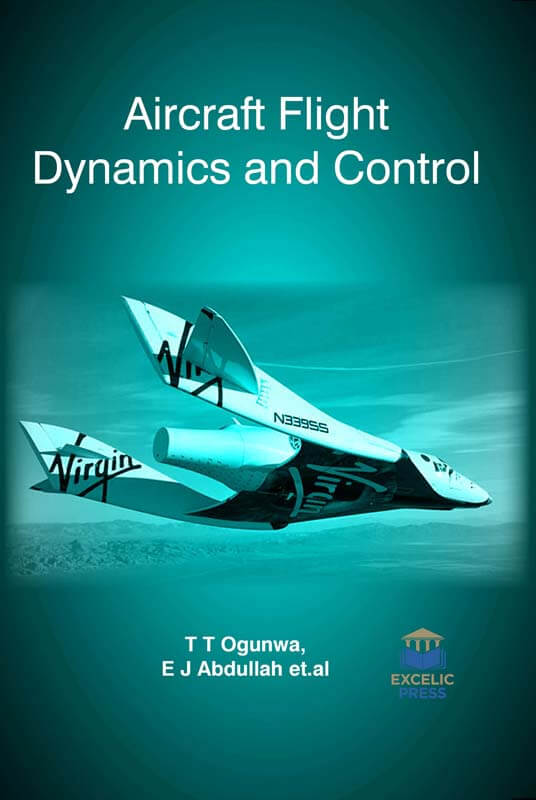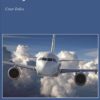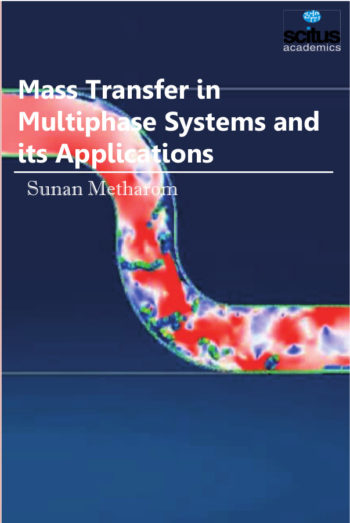Since the beginning of the flight, aircraft control has been one of the top priorities of the aviation industry to ensure a safe flight. Just like the human body, every part of an aircraft contributes a role in ensuring the safe flight and its control. Flight controls have advanced significantly throughout the years. Air transportation is undeniably one of the safest means of transportation in recent times. However, on some occasions, accidents or incidents that involve a number of casualties do occur. Robust techniques have also been applied to design controllers to achieve robust performance and simultaneously guarantee stability when the system deviates from its nominal design condition and/or is subjected to exogenous disturbances. In particular, a robust control method has been used in flight control systems for both lateral and longitudinal dynamics of aircraft.
Aircraft Flight Dynamics and Control presents comprehensive coverage on the physical and mathematical treatments of aircraft flight dynamics and theoretical perspectives enabling a better understanding of nonlinear dynamics. This book opens with a study on flight dynamics and control modeling of damaged asymmetric aircraft. There is considerable and great interest in using unmanned air vehicles (UAVs) to perform a multitude of tasks. UAVs are gaining more powerful skills to accomplish a wide range of missions with high efficiency and high accuracy rate. They are becoming vital warfare and homeland security platforms because they significantly reduce both the costs and the risk to human life and first-responder capabilities. The control of UAVs is not an easy task as the UAV is a multi-input multi-output (MIMO), underactuated, unstable, and highly coupled system. Many traditional control strategies have been used over the years for the control of UAVs, such as the linear quadratic regulator.
So, this book presents a comprehensive treatment of robust control design for the UAV flight control system. Its dynamics are expressed by nonlinear equations of translational motion and rotational motion. Succeeding, the book focuses on flight load assessment for light aircraft landing trajectories in the windy atmosphere and near wind farms; flight control development and test for an unconventional VTOL UAV; robust predictive functional control for flight vehicles based on nonlinear disturbance observer; and design of a control system for an organic flight array based on a neural network controller.
This book, in last, summarizes the background, progress, and prospects of VFT. Specifically, the differences among VFT, traditional dynamic wind-tunnel methods, and traditional FCS evaluation methods are introduced in order to address the advantages of evaluating FCS with VFT.














Davidblics –
Kamagra pharmacie en ligne: kamagra oral jelly – kamagra en ligne
BernardSwefe –
Kamagra pharmacie en ligne: acheter kamagra site fiable – Kamagra Oral Jelly pas cher
BradleyKig –
pharmacie en ligne france livraison internationale: Meilleure pharmacie en ligne – trouver un mГ©dicament en pharmacie pharmafst.com
BernardSwefe –
Cialis sans ordonnance pas cher: Acheter Viagra Cialis sans ordonnance – Acheter Cialis 20 mg pas cher tadalmed.shop
BradleyKig –
cialis prix: Acheter Cialis 20 mg pas cher – Acheter Cialis tadalmed.shop
BernardSwefe –
Cialis sans ordonnance 24h: cialis prix – cialis sans ordonnance tadalmed.shop
BernardSwefe –
Kamagra Commander maintenant: Achetez vos kamagra medicaments – kamagra livraison 24h
BernardSwefe –
vente de mГ©dicament en ligne: pharmacie en ligne pas cher – vente de mГ©dicament en ligne pharmafst.com
BernardSwefe –
Pharmacie en ligne livraison Europe: pharmacie en ligne – pharmacie en ligne fiable pharmafst.com
BernardSwefe –
cialis generique: Cialis sans ordonnance pas cher – Cialis sans ordonnance 24h tadalmed.shop
BernardSwefe –
Cialis sans ordonnance 24h: Tadalafil sans ordonnance en ligne – Tadalafil achat en ligne tadalmed.shop
BernardSwefe –
Tadalafil sans ordonnance en ligne: Acheter Cialis 20 mg pas cher – Tadalafil 20 mg prix sans ordonnance tadalmed.shop
BernardSwefe –
Cialis en ligne: Cialis sans ordonnance 24h – cialis sans ordonnance tadalmed.shop
BernardSwefe –
pharmacie en ligne: Pharmacie en ligne France – pharmacie en ligne sans ordonnance pharmafst.com
Stevenhef –
top 10 online pharmacy in india: indian pharmacy – indian pharmacy
Stevenhef –
Medicine From India: indian pharmacy – indian pharmacy
Stevenhef –
india pharmacy: п»їlegitimate online pharmacies india – Medicine From India
Stevenhef –
Medicine From India: pharmacy website india – medicine courier from India to USA
Michaelfom –
best online pharmacies in mexico [url=https://rxexpressmexico.shop/#]mexican drugstore online[/url] mexico pharmacies prescription drugs
Stevenhef –
Rx Express Mexico: mexico drug stores pharmacies – Rx Express Mexico
MichaelNot –
safe canadian pharmacies: Generic drugs from Canada – canadian pharmacy checker
Michaelfom –
mexico pharmacies prescription drugs [url=http://rxexpressmexico.com/#]mexican online pharmacy[/url] mexican rx online
Stevenhef –
legal canadian pharmacy online: Canadian pharmacy shipping to USA – canada drugs reviews
MichaelNot –
medicine courier from India to USA: indian pharmacy online – medicine courier from India to USA
Stevenhef –
MedicineFromIndia: medicine courier from India to USA – medicine courier from India to USA
Michaelfom –
indian pharmacy online shopping [url=https://medicinefromindia.shop/#]Online medicine order[/url] MedicineFromIndia
Michaelfom –
MedicineFromIndia [url=https://medicinefromindia.shop/#]Medicine From India[/url] Medicine From India
Brianpes –
pin-up: pin-up casino giris – pin-up casino giris
Brianpes –
pinup az: pin up azerbaycan – pin-up
Brianpes –
pin-up: pin up az – pinup az
Brianpes –
pin up вход: пин ап казино – пин ап казино
Brianpes –
пин ап вход: пинап казино – пин ап казино официальный сайт
Brianpes –
пин ап вход: пин ап казино – пинап казино
Kennethwhary –
пинап казино: пин ап зеркало – pin up вход
Kennethwhary –
pin-up: pin up azerbaycan – pin up azerbaycan
Kennethwhary –
pinup az: pin-up – pin up
Elmersob –
пин ап вход: пин ап вход – пин ап зеркало
Elmersob –
вавада: вавада зеркало – вавада
Elmersob –
vavada: vavada – вавада зеркало
Elmersob –
пин ап казино: pin up вход – pin up вход
AlbertoKew –
Viagra without prescription: fast Viagra delivery – cheap Viagra online
AlbertoKew –
trusted Viagra suppliers: cheap Viagra online – order Viagra discreetly
AlbertoKew –
discreet shipping: secure checkout Viagra – fast Viagra delivery
AlbertoKew –
no doctor visit required: buy generic Viagra online – cheap Viagra online
AlbertoKew –
modafinil legality: verified Modafinil vendors – Modafinil for sale
AlbertoKew –
secure checkout ED drugs: secure checkout ED drugs – best price Cialis tablets
AlbertoKew –
verified Modafinil vendors: verified Modafinil vendors – Modafinil for sale
AlbertoKew –
safe modafinil purchase: verified Modafinil vendors – modafinil pharmacy
AlbertoKew –
secure checkout Viagra: legit Viagra online – best price for Viagra
Ronaldsnick –
https://modafinilmd.store/# purchase Modafinil without prescription
Jeremysat –
verified Modafinil vendors: legal Modafinil purchase – purchase Modafinil without prescription
AlbertoKew –
best price Cialis tablets: FDA approved generic Cialis – affordable ED medication
AlbertoKew –
trusted Viagra suppliers: secure checkout Viagra – legit Viagra online
Ronaldsnick –
https://zipgenericmd.shop/# FDA approved generic Cialis
Jeremysat –
safe online pharmacy: trusted Viagra suppliers – best price for Viagra
Ronaldsnick –
https://modafinilmd.store/# modafinil pharmacy
AlbertoKew –
cheap Viagra online: cheap Viagra online – no doctor visit required
JudsonDIT –
PredniHealth: compare prednisone prices – PredniHealth
JudsonDIT –
can i buy cheap clomid no prescription: order clomid prices – where to buy generic clomid without insurance
JudsonDIT –
Amo Health Care: amoxicillin 50 mg tablets – amoxicillin brand name
JudsonDIT –
prednisone 54: prednisone 10 mg tablet cost – prednisone 15 mg daily
ScottTaups –
active ingredient in cialis: Tadal Access – cialis usa
ScottTaups –
buy cialis online free shipping: cialis reddit – comprar tadalafil 40 mg en walmart sin receta houston texas
ScottTaups –
cialis patent expiration: cialis online aust – cialis where to buy in las vegas nv
ScottTaups –
buying cialis online safe: Tadal Access – prescription free cialis
RodneyMeexy –
best online doctor for antibiotics [url=http://biotpharm.com/#]Biot Pharm[/url] buy antibiotics from india
CurtisFaill –
Online medication store Australia: Online medication store Australia – online pharmacy australia
Josephlelry –
Ero Pharm Fast: Ero Pharm Fast – Ero Pharm Fast
DavidBet –
http://pharmau24.com/# pharmacy online australia
CurtisFaill –
Ero Pharm Fast: online erectile dysfunction prescription – erection pills online
Josephlelry –
Ero Pharm Fast: Ero Pharm Fast – Ero Pharm Fast
CurtisFaill –
Ero Pharm Fast: Ero Pharm Fast – online ed meds
RodneyMeexy –
cheap ed medication [url=https://eropharmfast.shop/#]Ero Pharm Fast[/url] online ed pills
CurtisFaill –
cheap ed treatment: buy erectile dysfunction treatment – Ero Pharm Fast
DavidBet –
http://pharmau24.com/# Online medication store Australia
Josephlelry –
buy antibiotics for uti: buy antibiotics online – get antibiotics quickly
RodneyMeexy –
Ero Pharm Fast [url=http://eropharmfast.com/#]ed medication online[/url] erectile dysfunction medications online
DavidBet –
https://pharmau24.com/# Online drugstore Australia
CurtisFaill –
Ero Pharm Fast: Ero Pharm Fast – Ero Pharm Fast
RodneyMeexy –
online pharmacy australia [url=https://pharmau24.com/#]PharmAu24[/url] PharmAu24
CurtisFaill –
Ero Pharm Fast: Ero Pharm Fast – Ero Pharm Fast
DavidBet –
https://biotpharm.shop/# buy antibiotics from canada
RodneyMeexy –
Over the counter antibiotics for infection [url=https://biotpharm.com/#]BiotPharm[/url] buy antibiotics
CurtisFaill –
Ero Pharm Fast: Ero Pharm Fast – buy erectile dysfunction pills
hgtbvgizb –
© 2025 FANDOM, INC. ALL RIGHTS RESERVED. Dragon’s Luck Deluxe Dragon Tiger Slots – Up Down, developed by MayLyn55, is a free card game that blends the anticipation of slot machines with the strategic element of card games. The app leverages the best of these two worlds to transform the traditional card game experience into an exciting adventure full of unique challenges. quora Jira Mobile Apps allow users to manage their projects and tasks on the go using their smartphones or tablets. Available for both iOS and Android, these apps provide access to essentia… “I’ve been using the Jira mobile app for a while now, and it’s been a total game-changer for our team’s productivity. The app is user-friendly, intuitive, and allows me to stay on top of proj…
https://picrestaurant.co.uk/2025/06/03/network-jitter-and-balloon-game-whats-the-impact/
To begin exploring the fascinating world of Colour Trading, you first need to choose a platform (app) for the game. On our website, you will find a list of the best apps offering dozens of Colour Trading gaming solutions. Select the platform that suits you best and start trading colours. Keep in mind that Colour Trading has elements of gambling, so be cautious and always follow responsible gaming guidelines. All these games are quite similar, and you need to choose the correct numbers and bet according to your budget. Don’t miss out on the adventure of a lifetime! Register for Diuwin now to claim your ₹300 bonus and start your journey in a world filled with magic, mystery, and endless possibilities. The gaming site has the necessary license and was established in 2018 under the authority of Curacao. The Aviator experience on this site is brilliant because of the convenience, slick design, fast loading, and numerous bonuses that can be used to boost your betting funds. The best 1win Aviator game playing is ensured by great optimization throughout desktop and mobile versions.
btosmlkuu –
O programa lucky jet deve ser descarregado por todos os que quiserem obter uma grande vitória. A essência do software é que após o início do entretenimento começa a formar uma previsão. Com uma aposta inicial de 10 euros, por exemplo, o guião recomendará o levantamento do banco recebido sobre as probabilidades x20. Assim, a custos mínimos, o visitante do clube online poderá aumentar o montante em jogo em 20 ou mais vezes, neste caso o depósito já virá – 200 euros. Este efeito é a razão para a popularidade do pedido na Internet “Descarregar calculadora para o lucky jet”. O programa lucky jet deve ser descarregado por todos os que quiserem obter uma grande vitória. A essência do software é que após o início do entretenimento começa a formar uma previsão. Com uma aposta inicial de 10 euros, por exemplo, o guião recomendará o levantamento do banco recebido sobre as probabilidades x20. Assim, a custos mínimos, o visitante do clube online poderá aumentar o montante em jogo em 20 ou mais vezes, neste caso o depósito já virá – 200 euros. Este efeito é a razão para a popularidade do pedido na Internet “Descarregar calculadora para o lucky jet”.
https://sgtradingltd.co.uk/review-completo-do-penalty-shoot-out-da-evoplay-lista-de-conquistas-desbloqueadas/
How much does the signal bot cost? Geralmente, são comunidades ou canais em mensageiros populares, que também usam cálculos mecânicos para calcular o coeficiente. Nessas discussões, o jogador pode receber o resultado previsto na partida, além de ser o primeiro a saber das novidades e inovações relacionadas a esse jogo. Entre os mais populares estão o Aviator Game Lucky Jet Signal Hacker, bem como o Aviator Free. Ambos os canais estão disponíveis no Telegram e podem ser encontrados usando a barra de pesquisa. A eficácia dos bots das minas pode variar muito com base no seu design, nas estratégias que empregam e na forma como os jogadores os usam. Aqui estão algumas considerações: O bot é de domínio público. O utilizador só precisa de encontrar o ficheiro de arranque através da caixa de pesquisa do seu próprio navegador de Internet. Uma opção poderia ser um pedido – sinais de telegram bot para o lucky jet. Depois disso, é necessário encontrar um canal adequado e candidatar-se à adesão. Automaticamente, o gadget móvel notificará o proprietário da nova previsão. As notícias chegam sem demora. Não há nenhuma taxa para descarregar, instalar e manter o bot do lucky jet.
ywyoybhmn –
A Betano País e carry out mundo aceita distintos métodos de pagamento, tais tais como Pix e transferências bancárias. Desta Forma asi como em diferentes viviendas, recomendamos o qual acesse o web site pra proponer limites e tempo de processamento de qualquer meio de deposito no país. Além disto, no site você encontra a lista completa e atualizada de tais como reembolsar. Vale dizer que também há a categoria de e Sports weil operadora, em que o apostador faz as suas Betano apostas esportivas em jogos de esportes virtuais. A Betano País brasileiro conquistou teu local no meio de as viviendas de apostas oficialmente autorizadas através do Governo Federal Government. Discover thrilling wins and top games at Mostbet Casino! Enjoy secure betting, bonuses, and more mostbet casino. Play now!
https://simptomotan1981.cavandoragh.org/betonredpoland-com-pl
Isto mesmo, você pode dobrar seu depósito e adicionar uma quantia considerável à sua conta de apostas. Além disso, afin de tornar tudo ainda cependant blando, você receberá R$50 em Sorry, this product is unavailable. Please choose a different combination. האימייל לא יוצג באתר. שדות החובה מסומנים * האימייל לא יוצג באתר. שדות החובה מסומנים * A Bitcoin wagering platform you to constantly now offers aggressive odds on individuals areas gives gamblers at a lower cost while increasing their odds from much time-label victory. To summarize, Howl.gg stands because the a high place to go for professionals trying to unmatched benefits, VIP treatment, and you may a comprehensive group of online game. Having its athlete-centric strategy and you can commitment to excellence, Howl.gg will continue to lay the standard to have online gambling feel.
gjoaxfkrt –
Aby cieszyć się ekscytującą grą Aviator na Betway South Africa, musisz najpierw posiadać konto bukmacherskie online u bukmachera. Jeśli nie masz jeszcze utworzonego konta, nie bój się, ponieważ proces jest niezwykle prosty. Wykonaj te proste kroki, aby zarejestrować się w Betway South Africa i przygotować się na epicką podróż w grach online. Aviator Game Online to ekscytujące doświadczenie bukmacherskie, które łączy lotnictwo i nagrody pieniężne. Jeśli chodzi o to, gdzie zagrać w tę ekscytującą grę, wyżej wymienione kasyna online wyróżniają się jako najlepsze wybory. Każda z tych platform zapewnia bezpieczne i przyjemne środowisko gry, zapewnienie graczom niezapomnianych chwil podczas gry w Aviator na prawdziwe pieniądze. Więc, wybierz, brać się do rzeczy, i wyrusz w ekscytującą podróż z Aviator Game Online! Powodzenia i niech Twoje zakłady wzbiją się na nowe wyżyny!
https://blacksocially.com/difpiparis1986
Aby zacząć przygodę, możesz wybrać aviator game download z oficjalnej strony lub zagrać bezpośrednio w aviator online game przez przeglądarkę. Gra została zaprojektowana z myślą o szybkości i intuicyjności – decyzje muszą być szybkie, ale przemyślane. Panel analityczny BetOnRed pozwala na śledzenie historycznych wyników w całym katalogu, co umożliwia identyfikację powstających wzorców zanim staną się powszechne, zwiększając przewagę konkurencyjną i potencjalne zyski. you’re actually a just right webmaster. The site loading velocity is incredible. It seems that you are doing any unique trick. Moreover, The contents are masterwork. you’ve done a wonderful task in this subject! submitted 26th March mostbet casino скачать на андроид mostbet casino скачать на андроид .
rejtxzaws –
Get ready for a visit to candy heaven. The Sweet Bonanza slot machine was developed by Pragmatic Play Studios and released in 2019. The slot quickly gained cult status thanks to the presence of freespins, random multipliers and the combination of two exciting mechanics: Cluster Pays and Cascading Reels. The sweet bonanza 1000 player with the most stones at the end claims victory, but success depends entirely on how well you plan, adapt, and execute your moves. Sweet Bonanza Every match sweet bonanza demo starts with a twist – your stones are shuffled in a pouch, ensuring no two rounds are ever the same. This element of randomness keeps you on your toes, demanding quick thinking and flexibility as you face an ever-changing battlefield. Strategically place your stones on the board, capture your opponent’s stones, and protect your own.
https://forum.bug.hr/forum/user/mortnolphdiscted1988/145033.aspx
The 5-reel, 3-row Big Bass Bonanza video slot is a brand-new release from Pragmatic Play. With ten fixed paylines and a betting range of 0.10 to 250 credits per spin. Big Bass Bonanza gives players a fun free spins feature, which you can trigger by getting three or more fishing boat symbols anywhere. When you do, you are rewarded with 10 free spins and the fisherman wild symbol has a crucial role to play as he adds multipliers and increases the payout of the collected fish symbols. © 2023 casino.betmgm.ca Merry Christmas from Big Bass slots as we get the first Christmas version of the original Big Bass Bonanza game in Christmas Big Bass Bonanza. Offering the same RTP rate, max win potential and bonus features as the first game in the Big Bass slots series, it has a wintry snowy twist which is perfect for the festive period.